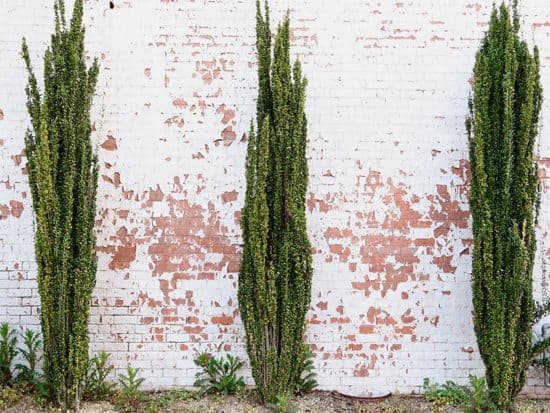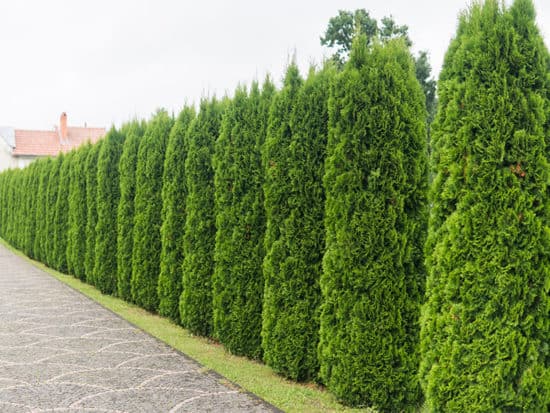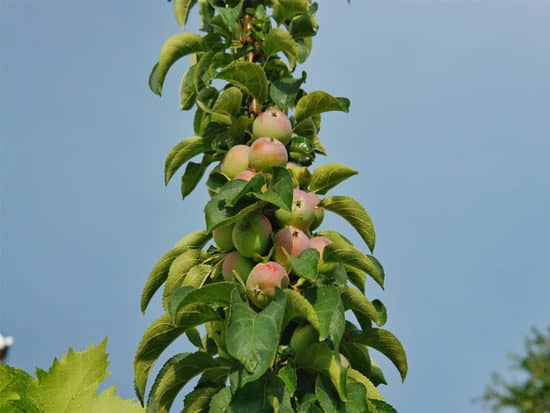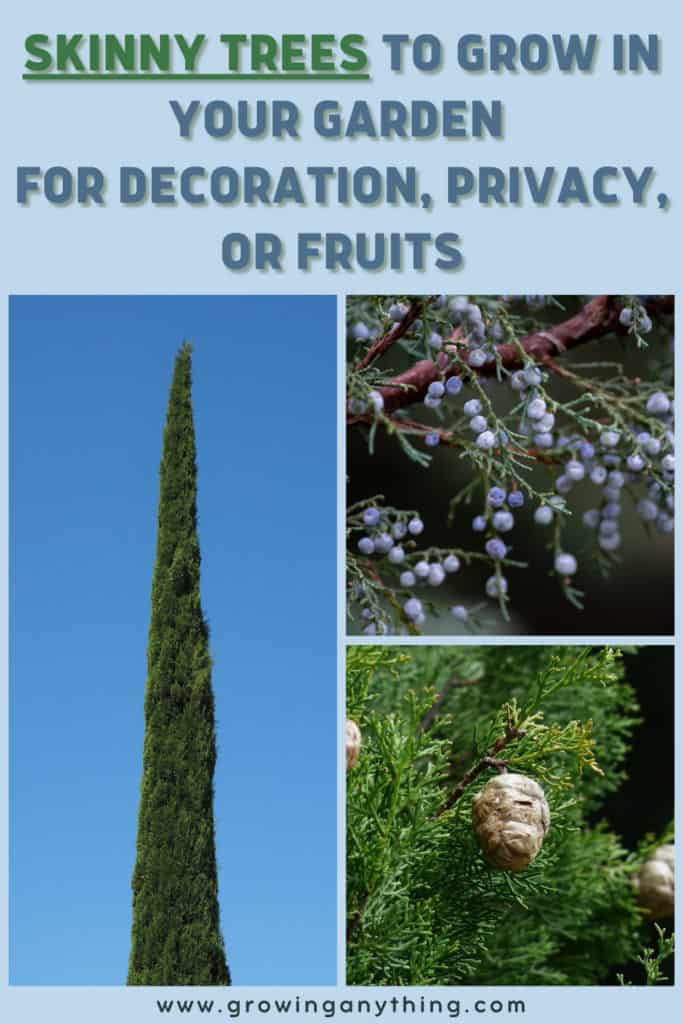Top 7 Skinny Trees
Skinny trees make a perfect choice for smaller gardens. They cover small space, but because some types can grow tall, skinny trees create the effect of rich and well-used space. Today, I am explaining how to grow skinny trees in your garden and utilize the space the best.
First of all, skinny trees are often called columnar trees and Fastigiate trees because of their look.
Some types are grown because of the shade they provide, but often for decorative purposes. Also, because many tall skinny trees are evergreens, they provide much-needed privacy around the house year-round.
Let’s check the most common types of skinny trees and learn how you can grow them in your garden.
Columnar Trees VS Fastigiate Trees
Generally, many people use the terms columnar and fastigiate trees interchangeably. But, there is a slight difference in the shape of these trees. Both are used for small gardens and landscape design due to their elegant look.
- Columnar Trees
Columnar trees have short branches and a spear-like shape. They grow much taller than they do in width. Most of the columnar trees have only one trunk and the branches are directed upright.
Good examples include Leyland cypress, Columnar apple, and Columnar peach. Their origin is, most often, natural mutations.
- Fastigiate Trees
Fastigiate trees are a result of nursery selection. They have multiple trunks, but still hold the upright, skinny look. The best examples are Upright European hornbeam and Fastigiate Ginkgo Biloba.
Skinny Evergreens
Many people choose evergreens for their yard because of the simple maintenance and beautiful look year-round. Also, there are so many cultivars of skinny evergreens that make a stunning decor in your garden. Moreover, some are easy to grow and fast growers as well.
For example, the most common skinny evergreens you can plant in your garden are:
- Sky Pencil Holly
- Moonglow Juniper
- Blue Arrow Juniper
- Pencil point Juniper
- Arborvitae Emerald Green – Thuja
- American arborvitae
- Italian cypress
Top 7 Skinny Trees for Every Garden
Let’s go briefly through the easiest method of growing the most popular varieties of skinny trees. Overall, you can go through the tips and see which skinny tree types meet all your preferences.
How to grow Sky Pencil Holly?
Let’s start with the easiest skinny tree to grow – Sky Pencil Holly.
It is a versatile skinny tree, but it needs a bit of help to maintain its columnar and narrow shape. Sky Pencil Holly can be used for making a shade or as wind protection.
IMAGE: Sky Pencil Holly is a versatile tree, an ideal choice for minimalist urban gardens.

• Sky Pencil Holly Basic Information
The maximum height a Sky Pencil Holly can reach is around 8 feet, while the width is less than 2 feet. If you prune it well, it reaches 6 feet and only 12 inches in width, and it is perfect for tight spaces and small gardens.
Also, you can grow this tree in containers and use them to frame the doorway.
• Planting Sky Pencil Holly
The tree enjoys full sun but can be grown in partial shade as well. Further, it needs well-drained soil to grow to its full potential.
Once you find the location for your Sky Pencil Holly, you’ll have to dig the hole around the size of a root ball. Make sure that the hole is two times wider, to leave enough space for roots to develop.
If the soil in your yard is heavy clay, you can use compost to improve the soil quality. Put the tree in the hole, and as you fill it, remove the air pockets by pressing the soil with your foot or hand.
Don’t forget to water your freshly-planted tree!
If you amend the root zone with three inches of organic mulch, it will keep the soil moist, which is especially important as the tree grows.
You need fertilizer only in the first spring after you’ve planted the tree.
• Maintenance
Sky Pencil Holly is simple to maintain. The tree doesn’t need pruning for remaining healthy, but it requires occasional pruning to maintain its skinny and elegant look.
The best time for pruning the tree is winter because the plant is dormant.
After the winter, you can use broadleaf fertilizer for evergreens. The alternative is one pound of 10-6-4 fertilizer.
Apply it to the root zone and water it.
Once your tree is established, you only need to water it during dry periods.
How to Grow Italian Cypress?
Italian cypress is a stunning columnar tree that is a traditional part of formal gardens. It is also a great choice to improve the look of your garden quickly because it grows fast. Moreover, the Italian cypress is maintenance-free!
IMAGE: Tall Italian cypress makes a charming garden piece when you mix it with other trees and flowers!

• Italian Cypress Basic Information
It is a very tall and strictly upright tree. My Italian cypress is around 50 feet tall. Generally, the maximum height of the Italian cypress is 70 feet. Still, it is skinny because it only grows about 10 feet in width.
The tree can grow about 3 feet per year if you ensure a good location.
• How to Plant Italian Cypress?
Plant your Italian cypress in the fall by digging the holes five times wider than root balls and about the same depth. You need to ensure that your Italian cypress has enough space to expand its roots. Smaller holes will girdle the root balls.
• Maintenance
Water your Italian cypress regularly, and start after planting the tree. However, it is important to ensure proper irrigation of the soil.
Also, the Italian cypress is a healthy tree, but it is prone to spider mites. To identify if the bugs have attacked, you can shake the tree occasionally. Once you notice small red bugs, spray the tree with water to help the tree dislodge them.
How to Grow Arborvitae?
IMAGE: Arborvitae is the most common choice for people bordering sidewalks and for privacy.

Whichever cultivar of famous Arborvitae (Thuja) you choose, it will make a perfect landscape detail due to its stunning pyramidal shape and overall attractive look. They do best in full sun or partial shade. Moreover, the ideal soil for Thuja needs to drain well and doesn’t include rocks or weeds that they need to compete against for water.
People often plant Arborvitae in lines for creating an attractive landscape or ensuring privacy. A grown-up thuja can be 10 to 15 inches wide, so ensure that distance between the two plants.
• How to Plant Arborvitae?
Plant your Arborvitae in the early spring or fall if you live in the South. Arborvitaes usually come with the root ball in the sack or plastic container. So, dig the hole as deep as the sack or the container, but twice wider. Start filling the hole, and when you are about at the half, water the soil generously. Next, complete filling the hole, and water again.
• Maintenance
Arborvitae needs a lot of water, around two gallons per week. Once you first plant your tree, water it more frequently until it establishes its growth.
These trees grow well in containers, but you might need to prune them to ensure the desired look. What is great about this skinny tree is that it can withstand heavy pruning. Pruning is best when done in early spring or mid-summer. That way, you will leave the plant enough time to heal and develop new branches.
How to Grow Junipers?
There are several skinny and tall species of junipers, similar to grow and care for. Junipers are best when grown around the fence or to mark the entrance. They are simple to grow and care for, and my favorite variety is Moonglow juniper.
- Junipers Basic Information
Different varieties of junipers can grow up to 40 feet tall and from 1 to 20 feet wide. It makes them an excellent choice for different-style gardens and for providing shade.
Junipers love the sun and well-drained, humus soil.
- How to Plant Junipers?
The best time for planting junipers are spring and summer. But, if you purchase the variety grown in a container, it can be planted any time of the year. But, if you buy the one with burlap roots, I recommend planting in the fall.
The procedure is similar to planting Arborvitae. You need to dig a hole as deep as the root, and twice as wider. As you refill the hole, make sure to press the soil to eliminate the air pockets.
It is important to water the tree frequently and generously in the first couple of months after planting.
- Maintenance
Once your juniper tree has been established, it needs almost zero maintenance. You only need to water it during the dry season for the first two years. After that time, the tree can grow on its own and even survive the drought.
You can mulch with pine needles in the first couple of years if the soil isn’t moist enough. To boost the growth, you can amend the soil with fertilizer in spring. Use compost or organic plant food.
If you want to prune your juniper tree, you should do it in late winter, after the extreme cold temperatures. Also, the junipers are deer-resistant due to their bristly needles.
How to Grow Columnar Fruit Trees?
If you want to grow an edible garden but have a small space to work with, columnar fruit trees are excellent choices. The most common choices are apple and peach.
The columnar fruit trees are easy to grow and do well in containers, too. They don’t require pruning and when grown properly, they award you with delicious fruits!
Columnar fruit trees grow upwards and have a single trunk with short branches. They produce fruit of standard size, but usually, there is less fruit than on normal-size trees.
• How to Plant Columnar Fruit Trees?
The skinny apple tree, for example, can grow up to 8 feet in height and reach 2 feet in width. Therefore, make sure to leave enough space for the tree to grow in height.
Plant the tree in a sunny location, but ensure that you can plant at least two trees to ensure pollination and fruit-producing. Pick at least two trees from two different apple varieties and plant them in the 100 feet area max. Keep the distance between the trees around 2 feet. My favorite varieties of columnar apple trees are Northpole, Golden, and Scarlet Sentinel.
If you want to grow your tree in the container, pick the 20 x 20 container.
Before you plant the tree, you can roughen up the root ball. Columnar apples placed higher in the soil will grow shorter and vice versa. Therefore, if you want a taller tree, dig a deeper hole for planting the tree.
IMAGE: The fruit from the columnar apple tree is delicious!

• Maintenance
Skinny fruit trees require watering during the fruit season, and that is about it. However, columnar tree fruits need a bit of pruning. You can cut back all branches of 20 cm to 5-15 cm. Prune your trees two times per year, before the growing season, and in the mid-summer.
To feed your trees and support the growth, you can apply balanced fertilizer during the growing season. The alternative is time-release fertilizer once a year.
How to Grow Crimson Pointe Cherry?
Crimson Pointe cherry is one of the most beautiful skinny trees you can grow in your garden. This skinny tree is known for its purple foliage and charming white blossoms. People often use it for street planting and as a central piece in the garden.
- Crimson Pointe Cherry Basic Information
The Crimson Pointe is one variety of cherry trees and is often called flowering cherry, or flowering cherry plum. The tree can grow to 20 feet in height, and less than 5 in width. Due to its beautiful, bronze leaves, white flowers, and narrow growth habit, the tree is great for filling the bald spots around sidewalks.
It enjoys full sun and tolerates different soil conditions. The plant delivers small fruit in summer.
- How to plant the Crimson Pointe Cherry?
The plant grows well in 3-gallon pots, but you can plant it directly to the well-drained soil. All you have to do is dig a hole that can hold the entire root ball, plant the tree and fill the soil. Then, water the soil generously.
- Maintenance
Your Crimson Pointe cherry isn’t challenging to maintain. People who live in hot and dry areas need to water the plant at least twice a week. But, if you live in a moderate climate, the rainfall will be enough.
To ensure the best growth, you can amend the soil with 5-5-5 fertilizer each year, in the early spring.
If you want your Crimson Pointe to hold its elegant columnar look, you can prune the tree when it goes dormant in winter.
However, before you start trimming the branches, remove the dead branches. Shape your tree as you want to match your garden style.
How to Grow Columnar Ginkgo Biloba Tree?
The fastigiate form of the famous Ginkgo Biloba tree makes a stunning element in every garden. It cannot grow as tall as the standard tree can, but it has the skinny, elegant look. Therefore, it is perfect for small gardens.
The tree tolerates urban pollution well and has excellent soil adaptability. Therefore, the skinny variation of the Ginkgo Biloba tree is easy to grow.
Some can grow from 50 to 75 feet tall while being only 10 feet wide.
- How to Plant Ginkgo Biloba Fastigiata
Generally, the tree has a slow growth rate. But, to boost the growth, plant the tree in full sun location, in the well-drained soil. Plant your tree during spring or fall.
Dig a hole that is big enough to accommodate the entire root ball. Next, backfill it and water it, and you’re done with your tree!
- Maintenance
Columnar form of the Ginkgo Biloba tree doesn’t need maintenance. You can occasionally water the tree and only prune if you notice that the branches are intertwined. If your tree looks healthy, you don’t have to introduce fertilizer.
But, if the foliage isn’t developing well, you can use a 10-5-5 fertilizer from October to March. That will boost the leaves’ growth.
How to use Skinny Trees in the Garden Landscape?
As I mentioned before, skinny trees make an ideal element to fill the tight and bald spaces.
But, there are several ways you can use them.
For example, when you plant skinny trees in a line, they can serve as a border, fence, shade, wind protection, etc. That way, you can use it in formal gardens or as background elements.
But, because there are so many skinny tree types with distinct foliage, some skinny trees can be used as central pieces in gardens, blended with other elements.
Additionally, you can use skinny trees to mark the sidewalks or for highlighting the entrance.
Because most skinny trees grow well in containers, they also make a pretty, shade-making decoration for balconies.
Conclusion
Skinny trees aren’t difficult to grow. Most of them require a similar process when first planting them in the garden. In short words, dig the hole big enough for the roots, fill it in, and water it. However, some types of skinny trees have different watering preferences and different purposes. They make a stunning visual element in small gardens and tight spaces.
Some skinny trees are grown especially for decorative purposes. Others can be used for wind protection, shade, or for improving your edible garden.
What skinny trees look the best to you? How would you use them in your garden?

